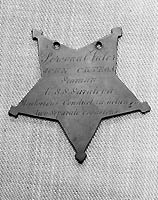
During the American Civil War, the Union Army, also called the Northern Army, referred to the United States Army, the land force that fought to preserve the Union of the collective states. Also known as the Federal Army, it proved essential to the preservation of the United States as a working, viable republic.

The New Mexico campaign was a military operation of the Trans-Mississippi Theater of the American Civil War from February to April 1862 in which Confederate Brigadier General Henry Hopkins Sibley invaded the northern New Mexico Territory in an attempt to gain control of the Southwest, including the gold fields of Colorado and the ports of California. Historians regard this campaign as the most ambitious Confederate attempt to establish control of the American West and to open an additional theater in the war. It was an important campaign in the war's Trans-Mississippi Theater, and one of the major events in the history of the New Mexico Territory in the American Civil War.

Gordon Granger was a career U.S. Army officer and a Union general during the American Civil War, where he distinguished himself at the Battle of Chickamauga.
The Military Order of the Loyal Legion of the United States (MOLLUS), or simply as the Loyal Legion is a United States patriotic order, organized April 15, 1865, by officers of the Army, Navy, or Marine Corps of the United States who "had aided in maintaining the honor, integrity, and supremacy of the national movement" during the American Civil War. It was formed by loyal Union military officers in response to rumors from Washington of a conspiracy to destroy the Federal government by assassination of its leaders, in the immediate aftermath of the assassination of President Abraham Lincoln. They stated their purpose as the cherishing of the memories and associations of the war waged in defense of the unity and indivisibility of the Republic; the strengthening of the ties of fraternal fellowship and sympathy formed by companionship in arms; the relief of the widows and children of dead companions of the order; and the advancement of the general welfare of the soldiers and sailors of the United States. As the original officers died off, the veterans organization became an hereditary society. The modern organization is composed of men who are descendants of these officers, and other men who share the ideals of the Order, who collectively are considered "Companions". A female auxiliary, Dames of the Loyal Legion of the United States (DOLLUS), was formed in 1899 and accepted as an affiliate in 1915.
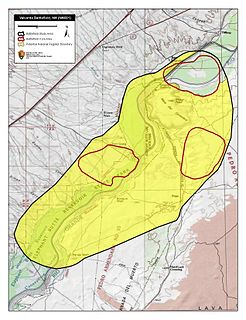
The Battle of Valverde, also known as the Battle of Valverde Ford, was fought from February 20 to 21, 1862, near the town of Val Verde at a ford of the Rio Grande in Union-held New Mexico Territory, in what is today the state of New Mexico. It was a major Confederate success in the New Mexico Campaign of the American Civil War. The belligerents were Confederate cavalry from Texas and several companies of Arizona militia versus U.S. Army regulars and Union volunteers from northern New Mexico Territory and the Colorado Territory.
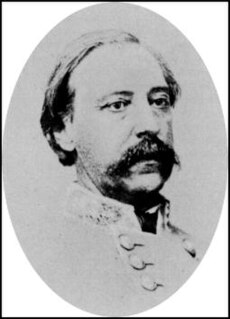
Goode Bryan was a planter, politician, military officer, and American Civil War general in the Confederate States Army. His brigade played a prominent role during the Battle of the Wilderness, fighting stubbornly until exhausting its ammunition.
The 2nd Wisconsin Infantry Regiment was an infantry regiment that served in the Union Army during the American Civil War. It spent most of the war as a member of the famous Iron Brigade of the Army of the Potomac. It suffered the largest number of casualties as a percentage of its total enlistment of any Union Army unit in the war.
The Irish military diaspora refers to the many people of either Irish birth or extraction who have served in overseas military forces, regardless of rank, duration of service, or success.

Alfred Gibbs was a career officer in the United States Army who served as a brigadier general in the Union Army during the American Civil War.

Hispanic Americans, also referred to as Latinos, served in all elements of the American armed forces in the war. They fought in every major American battle in the war. Between 400,000 and 500,000 Hispanic Americans served in the U.S. Armed Forces during World War II, out of a total of 16,000,000, constituting 3.1% to 3.2% of the U.S. Armed Forces. The exact number is unknown as, at the time, Hispanics were not tabulated separately, but were included in the general white population census count. Separate statistics were kept for African Americans and Asian Americans.

The 1st Arkansas Infantry (1861–1865) was a Confederate Army infantry regiment during the American Civil War. The regiment was raised in April 1861 by Colonel Thompson B. Flournoy. It moved first to Virginia, but transferred back to Tennessee and served the rest of the war in the western theater, seeing action in the Kentucky, Tennessee and Georgia campaigns. Following its depletion in numbers, the regiment was consolidated several times with other Arkansas regiments, finally merging in 1865 into the 1st Arkansas Consolidated Infantry Regiment. There were three regiments known as "1st Arkansas" during the war. The second unit with the designation of "1st Arkansas" was the 1st Infantry, Arkansas State Troops, which was mustered into Confederate service at Pitman's Ferry, Arkansas, on 23 July 1861, under the command of Colonel Patrick Cleburne; this unit was eventually redesignated as the 15th Arkansas Volunteer Infantry. The third unit bearing the title "1st Arkansas" was the 1st Arkansas Volunteer Infantry, which served with the Union Army.
The 21st Ohio Infantry Regiment was an infantry regiment in the Union Army during the American Civil War. Mostly an all-volunteer unit, with the exception of a few draftees, the 21st Ohio served for both ninety-day and three-year enlistments and fought exclusively in the Western Theater. It saw action in some of the war's bloodiest battles including Stones River, Chickamauga, the Atlanta Campaign, and Sherman's March to the Sea.
Hispanics and Latinos in the United States Navy can trace their tradition of naval military service to men such as Lieutenant Jordi Farragut Mesquida, who served in the American Revolution. Hispanics, such as Seaman Philip Bazaar and Seaman John Ortega, have distinguished themselves in combat and have been awarded the Medal of Honor, the highest military decoration of the United States. Latinos have also reached the top ranks of the navy, serving their country in sensitive leadership positions on domestic and foreign shores. Among those who have reached the highest ranks in the navy are Commodore Uriah Phillips Levy, of Sephardic and Ashkenazic Jewish descent, who participated in the War of 1812 as an assistant Sailing master; Admiral David Glasgow Farragut, for whom the rank of admiral in the U.S. Navy was created during the American Civil War; and Admiral Horacio Rivero, who led the navy during the Cuban Missile Crisis.
The Thirteenth Pennsylvania Reserve Regiment, also known as the 42nd Pennsylvania Volunteer Infantry, the 1st Pennsylvania Rifles, Kane's Rifles, or simply the "Bucktails," was a volunteer infantry regiment that served in the Union Army during the American Civil War. It was a part of the famed Pennsylvania Reserve division in the Army of the Potomac for much of the early and middle parts of the war, and served in the Eastern Theater in a number of important battles, including Antietam, Fredericksburg, and Gettysburg.

The 2nd Regiment Massachusetts Volunteer Infantry was an infantry regiment in the Union Army during the American Civil War. Major George H. Gordon, a West Point graduate and veteran of the Mexican-American War, organized the unit's recruitment and formation. The 2nd Massachusetts was trained at Camp Andrew in West Roxbury, Massachusetts on the site of the former Transcendentalist utopian community, Brook Farm. Roughly half the regiment was mustered in on May 18, 1861 and the remainder on May 25, 1861 for a term of three years. The regiment saw extensive combat as part of the Army of the Potomac particularly during the Battle of Antietam and the Battle of Gettysburg.
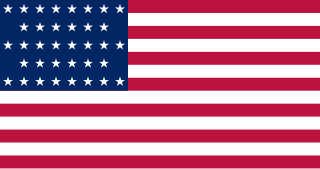
The 1st Regiment New Mexico Cavalry was a volunteer cavalry regiment in the Union Army during the American Civil War.
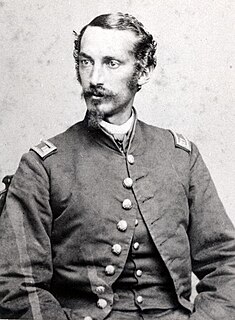
Federico Fernández-Cavada was an officer in the Union Army during the American Civil War and a diplomat, as well as commander-in-chief of all the Cuban forces during Cuba's Ten Years' War. Because of his artistic talents, he was assigned to the Hot Air Balloon Unit of the Union Army. From the air he sketched what he observed of enemy positions and movements. On April 19, 1862, Fernández Cavada sketched enemy positions from Thaddeus Lowe's Constitution balloon during the Peninsular Campaign in Virginia.

Adolfo Fernández Cavada was a soldier and diplomat, an officer in the Union Army during the American Civil War who served as captain in the Philadelphia 23rd Pennsylvania Infantry Regiment, a regiment of the Union Forces, with his brother, Colonel Federico Fernández Cavada. He served with distinction in the Army of the Potomac in the battles of Fredericksburg and Gettysburg and was a "special aide-de-camp" to General Andrew A. Humphreys. After the war, Fernández Cavada was appointed as consul in Cienfuegos, Cuba. He joined his brother, who had been in Trinidad, in the Cuban insurrection against Spanish rule and succeeded him as Commander-in-Chief of the Cinco Villas. He was killed in action.
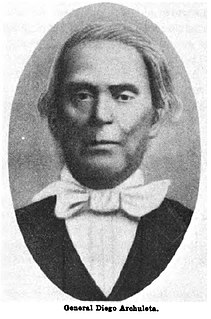
Brigadier General Diego Archuleta, was a member of the Mexican Congress. He joined the Mexican Army to fight against the United States in the Mexican–American War. Later, he was appointed an Indian Agent by President Abraham Lincoln, and joined the Union Army during the American Civil War. Archuleta became the first Hispanic to reach the military rank of Brigadier General.

















